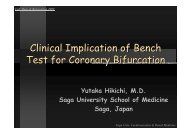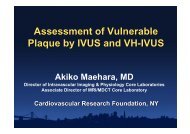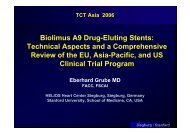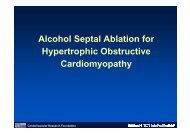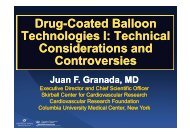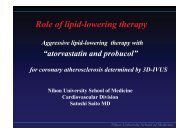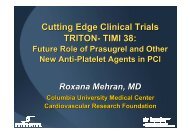Impact of Angiographic Complete ... - summitMD.com
Impact of Angiographic Complete ... - summitMD.com
Impact of Angiographic Complete ... - summitMD.com
Create successful ePaper yourself
Turn your PDF publications into a flip-book with our unique Google optimized e-Paper software.
<strong>Impact</strong> <strong>of</strong> <strong>Angiographic</strong> <strong>Complete</strong><br />
Revascularization after Drug-Eluting Stent<br />
Implantation or Coronary Artery Bypass<br />
Surgery for Multivessel Coronary Disease<br />
Young-Hak Kim, Duk-Woo Park, Jong-Young Lee, Won-Jang Kim, Sung-<br />
Cheol Yun, Jung-Min Ahn, Hae Geun Song, Jun-Hyok Oh, Jong Seon Park,<br />
Soo-Jin Kang, Seung-Whan Lee, Cheol Whan Lee, Seong-Wook Park,<br />
Seung-Jung Park<br />
Heart Institute, University <strong>of</strong> Ulsan College <strong>of</strong> Medicine<br />
Asan Medical Center, Seoul, Korea
<strong>Impact</strong> <strong>of</strong> <strong>Angiographic</strong> <strong>Complete</strong><br />
Revascularization (CR) after DES Implantation<br />
MI-free Survival in NY Registry<br />
Months<br />
Hannan EL et al. J Am Coll Cardiol Intv 2009;2:17
<strong>Impact</strong> <strong>of</strong> <strong>Angiographic</strong> CR<br />
after CABG Surgery<br />
Death, UA, MI, Hospitalization, & Repeat<br />
revascularization -free Survival<br />
CR (N=207)<br />
In<strong>com</strong>plete CR (N=105)<br />
P
But, <strong>Impact</strong> <strong>of</strong> CR needs to be<br />
further investigated.<br />
t • Due to technical <strong>com</strong>plexity, low ejection fraction, or safety<br />
concerns regarding the implantation <strong>of</strong> multiple DES,<br />
diseased segments have <strong>of</strong>ten been in<strong>com</strong>pletely<br />
revascularized in patients undergoing PCI.<br />
• Furthermore, even with CABG, the strategy <strong>of</strong> in<strong>com</strong>plete<br />
revascularization (IR) has occasionally been adopted to<br />
reduce operation-related <strong>com</strong>plications, particularly when<br />
minimally invasive or <strong>of</strong>f-pump surgery is attempted.<br />
• Additional studies are needed to assess the out<strong>com</strong>es <strong>of</strong><br />
updated treatments, such as DES, left internal mammary<br />
artery (LIMA) grafting, <strong>of</strong>f-pump surgery and current<br />
medications.
Purpose<br />
• We, therefore, evaluated the long-term clinical<br />
impacts <strong>of</strong> angiographic CR, as <strong>com</strong>pared<br />
with IR, in patients receiving PCI with DES or<br />
CABG for multivesel l coronary disease (MVD).
Subjects<br />
• 1914 Patients with MVD in the Asan Medical<br />
Center Multivessel Registry who underwent DES<br />
(N=1400) implantation ti or CABG (N=514)<br />
between January 2003 and December 2005 were<br />
included d in this study.<br />
• Patients who underwent prior CABG or<br />
con<strong>com</strong>itant valvular or aortic surgery, and those<br />
who had an acute myocardial infarction (MI)<br />
within 24 hours before revascularization or<br />
presented with cardiogenic shock were excluded.
Procedures<br />
• The choice <strong>of</strong> DES type and the use <strong>of</strong><br />
intravascular ultrasound, ,gy glycoprotein IIb/IIIa<br />
inhibitor, or other devices to facilitate optimal<br />
stenting were at the operator’s discretion.<br />
• In CABG, the LIMA primarily attempted to be<br />
grafted to the LAD artery.<br />
• On- or <strong>of</strong>f-pump surgery was performed at the<br />
operator’s discretion.
Decision <strong>of</strong> CR<br />
• Factors involved in the decision-making process<br />
included patient’s presentation and <strong>com</strong>orbidity,<br />
LV EF, objective ischemia evidenced by stress<br />
tests, jeopardized myocardium <strong>of</strong> the diseased<br />
segment, presence <strong>of</strong> viable myocardium, and<br />
anatomical <strong>com</strong>plexity.<br />
• PCI was preferred for patients at high surgical risk<br />
d t bi d bidit<br />
due to <strong>com</strong>bined morbidity.<br />
• CABG was considered as the primary option <strong>of</strong><br />
MVD in patients with severe angiographic<br />
<strong>com</strong>plexity or low LV EF.
End Points<br />
• MACE: all-cause death, MI, and stroke.<br />
• MACCE: MACE plus repeat revascularization.<br />
• MI: new pathologic Q waves after index treatment<br />
or follow-up MI requiring subsequent<br />
hospitalization.<br />
• Repeat revascularization included d target t vessel<br />
revascularization.<br />
• Stroke: neurologic deficits, was confirmed by a<br />
neurologist based on imaging modalities.<br />
• All out<strong>com</strong>es <strong>of</strong> interest were carefully verified<br />
and adjudicated by independent clinicians.
<strong>Angiographic</strong> g Analysis<br />
• Diseased segments and lesion characteristics<br />
were categorized according to the Synergy<br />
between PCI with Taxus and Cardiac Surgery<br />
(SYNTAX) classification.<br />
• CABG patients were assessed by <strong>com</strong>paring<br />
the diagnostic angiographic analysis with the<br />
surgical procedure report.<br />
• CR in PCI patients was assessed by<br />
<strong>com</strong>paring the diagnostic and post-procedural<br />
angiograms.
• <strong>Angiographic</strong> CR-1<br />
Definitions <strong>of</strong> CR<br />
- Revascularization <strong>of</strong> all SYNTAX segment (≥1.5 mm),<br />
consisting <strong>of</strong> RCA (# 1, 2 & 3), PDA (# 4 or 15), PL (#<br />
16), LAD (# 5, 6, 7 & 8), Diag (# 9 or 10), LCX (# 11<br />
&13), OM (# 12 or 14).
Definitions <strong>of</strong> CR<br />
• <strong>Angiographic</strong> CR-2<br />
- Revascularization <strong>of</strong> all SYNTAX segment (≥ 2.5 mm)<br />
• Proximal CR<br />
- Revascularization <strong>of</strong> all proximal arterial systems (# 1, 2,<br />
3, 5, 6, 7 & 11)<br />
• Multivessel IR<br />
- IR ≥ 2 diseased vessels<br />
• The LM (# 5) was considered d revascularized when the LAD<br />
was bypassed in the CABG group or directly treated<br />
percutaneously in the PCI group
Statistical Analysis<br />
• Adjustment using multivariable Cox proportional-<br />
hazards regression and weighted Cox<br />
proportional-hazards regression models with<br />
inverse-probability-<strong>of</strong>-treatment weighting<br />
(IPTW).<br />
• Interactions between factors associated with CR<br />
and treatment strategy were tested by<br />
incorporation <strong>of</strong> formal interaction terms in the<br />
multivariable Cox model.
Prevalence <strong>of</strong> CR<br />
according to the Definitions<br />
%<br />
100<br />
Overall PCI CABG<br />
80<br />
60<br />
40<br />
20<br />
0<br />
48<br />
41<br />
66<br />
69<br />
64<br />
79 78<br />
CR-1 CR-2 Proximal CR Multivessel IR<br />
62<br />
57<br />
19<br />
26<br />
5
Baseline Characteristics<br />
PCI<br />
CABG<br />
Variable<br />
CR IR CR IR<br />
P<br />
(N=573) (N=827)<br />
(N=344) (N=170)<br />
P<br />
Age, years 60.8±10.47 62.7±9.8
Baseline Characteristics<br />
Variable<br />
CR<br />
(N=573)<br />
PCI<br />
IR<br />
(N=827)<br />
P<br />
CR<br />
(N=344)<br />
CABG<br />
IR<br />
(N=170)<br />
COPD 3 (0.5) 12 (1.5) 0.10 7 (2.0) 6 (3.5) 0.37<br />
CVA 25 (4.4) 50 (6.0) 0.17 44 (12.8) 28 (16.5) 0.26<br />
Peripheral Ds 10 (1.7) 20 (2.4) 039 0.39 29 (8.4) 17 (10.0) 0) 056 0.56<br />
Renal failure 10 (1.7) 27 (3.3) 0.08 23 (6.7) 15 (8.8) 0.38<br />
Atrial fibrillation 20 (3.5) 24 (2.9) 054 0.54 9(26) (2.6) 3(18) (1.8) 076 0.76<br />
Clinical presentation 0.57 0.54<br />
Stable angina 275 (48.0) 420 (50.8) 115 (33.4) 58 (34.1)<br />
Unstable angina 245 (42.8) 338 (40.9) 209 (60.8) 106 (62.4)<br />
Acute MI 53 (9.2) 69 (8.3) 20 (5.8) 6(35)<br />
(3.5)<br />
P
<strong>Angiographic</strong> Characteristics<br />
PCI<br />
CABG<br />
Variable<br />
CR<br />
(N=573)<br />
IR<br />
(N=827)<br />
P<br />
CR<br />
(N=344)<br />
IR<br />
(N=170)<br />
P<br />
SYNTAX score 15.0±7.1 19.0±7.7
Procedures<br />
PCI<br />
CABG<br />
Variable<br />
CR IR CR IR<br />
P<br />
(N=573) (N=827) (N=344) (N=170)<br />
P<br />
CABG procedures<br />
No. <strong>of</strong> conduits<br />
− − −<br />
3.6±1.0 2.9±1.1
Cumulative Incidence <strong>of</strong> Events<br />
over 5 Years in All Patients t (N=1914)<br />
%<br />
40<br />
Yes No<br />
MACE MACCE<br />
P=0.91 0.82 0.84 0.10 p=0.21 0.20 0.30 0.001<br />
30<br />
20<br />
10<br />
0<br />
12.1 11.9 12.3 11.6 12.0 12.0 14.4 11.5 22.4 24.9 22.7 25.1 22.9 25.0 30.3 22.1<br />
CR-1 CR-2 Px CR Multi<br />
IR<br />
CR-1 CR-2 Px CR Multi<br />
IR
Cumulative Incidence <strong>of</strong> Events<br />
over 5 Years in All Patients t (N=1914)<br />
%<br />
40<br />
Yes No<br />
MACE MACCE<br />
P=0.91 0.82 0.84 0.10 p=0.21 0.20 0.30 0.001<br />
30<br />
20<br />
10<br />
0<br />
12.1 11.9 12.3 11.6 12.0 12.0 14.4 11.5 22.4 24.9 22.7 25.1 22.9 25.0 30.3 22.1<br />
CR-1 CR-2 Px CR Multi<br />
IR<br />
CR-1 CR-2 Px CR Multi<br />
IR
Cumulative Incidence <strong>of</strong> Events<br />
over 5 Years in PCI Patients t (N=1400)<br />
%<br />
40<br />
Yes No<br />
MACE MACCE<br />
P=0.11 0.34 0.30 0.094 p=0.35 0.61 0.81 0.034<br />
30<br />
20<br />
10<br />
0<br />
9.4 11.7 10.2 11.3 10.1 11.5 12.8 10.1 24.0 26.3 24.8 26.0 25.1 25.7 29.3 24.0<br />
CR-1 CR-2 Px CR Multi<br />
IR<br />
CR-1 CR-2 Px CR Multi<br />
IR
Cumulative Incidence <strong>of</strong> Events<br />
over 5 Years in PCI Patients t (N=1400)<br />
%<br />
40<br />
Yes No<br />
MACE MACCE<br />
P=0.11 0.34 0.30 0.094 p=0.35 0.61 0.81 0.034<br />
30<br />
20<br />
10<br />
0<br />
9.4 11.7 10.2 11.3 10.1 11.5 12.8 10.1 24.0 26.3 24.8 26.0 25.1 25.7 29.3 24.0<br />
CR-1 CR-2 Px CR Multi<br />
IR<br />
CR-1 CR-2 Px CR Multi<br />
IR
Cumulative Incidence <strong>of</strong> Events<br />
over 5 Years in CABG Patients t (N=514)<br />
%<br />
50<br />
40<br />
Yes No<br />
MACE MACCE<br />
P=0.35 0.53 0.86 0.008 p=0.73 0.74 0.48 0.014<br />
30<br />
20<br />
10<br />
0<br />
16.5 13.3 16.0 13.3 15.7 14.6 33.6 14.5 19.6 18.2 18.9 20.1 18.5 21.3 38.3 18.1<br />
CR-1 CR-2 Px CR Multi<br />
IR<br />
CR-1 CR-2 Px CR Multi<br />
IR
Cumulative Incidence <strong>of</strong> Events<br />
over 5 Years in CABG Patients t (N=514)<br />
%<br />
50<br />
40<br />
Yes No<br />
MACE MACCE<br />
P=0.35 0.53 0.86 0.008 p=0.73 0.74 0.48 0.014<br />
30<br />
20<br />
10<br />
0<br />
16.5 13.3 16.0 13.3 15.7 14.6 33.6 14.5 19.6 18.2 18.9 20.1 18.5 21.3 38.3 18.1<br />
CR-1 CR-2 Px CR Multi<br />
IR<br />
CR-1 CR-2 Px CR Multi<br />
IR
Unadjusted Mortality<br />
By <strong>Angiographic</strong> CR-1<br />
CR<br />
IR<br />
15<br />
10<br />
P=0.87<br />
8.9%<br />
89% 8.9%<br />
5<br />
0<br />
0 360 720 1080 1440 1800 Days<br />
At risk CR 917 877 858 835 806 603<br />
IR 997 949 917 899 861 541
Unadjusted Out<strong>com</strong>es in All Patients<br />
By <strong>Angiographic</strong> CR-1<br />
CR<br />
IR<br />
(%)<br />
40<br />
MACE (All) MACCE (All)<br />
30<br />
20<br />
10<br />
P=0.91<br />
p=0.21<br />
11.9<br />
12.1<br />
24.9<br />
22.4<br />
0<br />
0 360 720 1080 1440 1800 0 360 720 1080 1440 1800<br />
At risk<br />
IR 997 939 904 878 834 526 997 876 821 781 731 444<br />
CR 917 871 850 821 782 581 917 821 787 744 698 520
Unadjusted Out<strong>com</strong>es in PCI<br />
By <strong>Angiographic</strong> CR-1<br />
CR<br />
IR<br />
(%)<br />
40<br />
MACE (PCI) MACCE (PCI)<br />
30<br />
P=0.11 p=0.35<br />
26.3<br />
20<br />
24.0<br />
10<br />
11.7<br />
9.4<br />
0<br />
0 360 720 1080 1440 1800 0 360 720 1080 1440 1800<br />
At risk<br />
IR 827 780 749 731 691 411 827 722 672 641 594 336<br />
CR 573 557 546 528 501 350 573 511 490 459 424 296
Unadjusted Out<strong>com</strong>es in All Patients<br />
By Multivessel l IR<br />
Multi. IR+<br />
Multi. IR<br />
−<br />
(%)<br />
40<br />
MACE (All) MACCE (All)<br />
30<br />
P=0.10 p=0.001<br />
30.3<br />
20<br />
14.4<br />
22.1<br />
10<br />
11.5<br />
0<br />
0 360 720 1080 1440 1800 0 360 720 1080 1440 1800<br />
At risk<br />
MIR− M.IR− 1546 1467 1426 1383 1311 942 1546 1382 1317 1250 1172 833<br />
Mi.IR+ 368 343 328 316 305 165 368 315 293 275 257 132
Unadjusted Out<strong>com</strong>es in PCI<br />
By Multivessel l IR<br />
Multi. IR+<br />
Multi. IR<br />
−<br />
(%)<br />
40<br />
MACE (PCI) MACCE (PCI)<br />
30<br />
P=0.094 p=0.034<br />
29.3<br />
20<br />
12.8<br />
24.0<br />
10<br />
10.1<br />
0<br />
0 360 720 1080 1440 1800 0 360 720 1080 1440 1800<br />
At risk<br />
MIR− M.IR− 1056 1015 986 961 903 610 1056 939 888 843 777 513<br />
M.IR+ 344 322 309 298 289 151 344 294 274 257 241 119
Adjusted Out<strong>com</strong>es <strong>of</strong> MACE<br />
Multivariate adjustment<br />
IPTW<br />
Definitions<br />
HR<br />
95% CI<br />
95% CI<br />
p HR<br />
LL UL LL UL<br />
p<br />
<strong>Angiographic</strong> CR-1 1.04 0.80 1.36 0.75 1.04 0.79 1.36 0.80<br />
All<br />
<strong>Angiographic</strong> CR-2 1.05 0.80 1.38 0.72 1.09 0.83 1.44 0.53<br />
Proximal CR 1.04 0.79 1.37 0.80 1.00 0.75 1.32 0.97<br />
Multivessel IR 1.26 0.92 1.74 0.15 0.97 0.66 1.43 0.89<br />
<strong>Angiographic</strong> CR-1 0.82 0.58 1.15 0.25 0.84 0.59 1.20 0.33<br />
PCI<br />
<strong>Angiographic</strong> CR-2 090 0.90 065 0.65 125 1.25 053 0.53 095 0.95 068 0.68 133 1.33 077 0.77<br />
Proximal CR 0.90 0.65 1.25 0.53 0.95 0.67 1.34 0.76<br />
Multivessel l IR 130 1.30 091 0.91 187 1.87 015 0.15 105 1.05 070 0.70 159 1.59 081 0.81<br />
No interaction was found between the treatment type and any definition <strong>of</strong> CRs.
Adjusted Out<strong>com</strong>es <strong>of</strong> MACCE<br />
Multivariate adjustment<br />
IPTW<br />
Definitions<br />
iti<br />
HR<br />
95% CI<br />
95% CI<br />
p HR<br />
LL UL LL UL<br />
p<br />
<strong>Angiographic</strong> CR-1 0.90 0.75 1.09 0.29 0.91 0.75 1.10 0.32<br />
All<br />
<strong>Angiographic</strong> CR-2 0.89 0.73 1.07 0.21 0.92 0.76 1.12 0.40<br />
Proximal CR 0.92 0.76 1.12 0.40 0.90 0.74 1.10 0.30<br />
Multivessel IR 1.44 1.16 1.79 0.001 1.27 0.97 1.66 0.079<br />
<strong>Angiographic</strong> CR-1 0.95 0.76 1.18 0.62 0.94 0.75 1.18 0.61<br />
PCI<br />
<strong>Angiographic</strong> CR-2 099 0.99 080 0.80 122 1.22 090 0.90 100 1.00 081 0.81 125 1.25 099 0.99<br />
Proximal CR 1.01 0.82 1.26 0.90 1.04 0.83 1.30 0.73<br />
Multivessel IR 1.24 0.98 1.57 0.071 1.20 0.91 1.58 0.19<br />
No interaction was found between the treatment type and any definition <strong>of</strong> CRs.
Conclusions<br />
• Anatomical CR for all angiographic stenoses did<br />
not improve the long-term clinical out<strong>com</strong>es<br />
after either PCI or CABG in patients with MVD.<br />
• However, in patients with extensive coronary<br />
artery disease, multivessel IR may be<br />
associated with unfavorable long-term clinical<br />
out<strong>com</strong>es.<br />
• Therefore, the risks and benefits <strong>of</strong><br />
revascularization treatment may be balanced by<br />
an ischemia-guided revascularization strategy.



